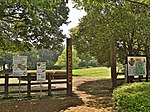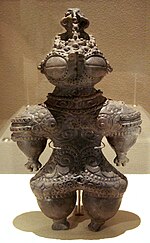The Haniwa (埴輪) are terracotta clay figures that were made for ritual use and buried with the dead as funerary objects during the Kofun period (3rd to...
14 KB (1,535 words) - 16:54, 20 May 2024
The Haniwa Terracotta Dancers (埴輪 踊る人々, haniwa odoru hitobito, haniwa dancing people) are a pair of human-shaped terracotta burial figures - haniwa - one...
10 KB (1,247 words) - 09:32, 10 November 2023
intelligent, he grows to be more cautious than his twin sister Haniwa. Nesta Cooper as Haniwa, the daughter of Baba Voss and Maghra, and the biological daughter...
89 KB (4,851 words) - 00:55, 4 July 2024
in the series Travelers. From 2019 to 2022, she played the main role of Haniwa on the Apple TV+ original program, See. At the age of seven, Cooper moved...
8 KB (499 words) - 06:59, 20 April 2024
The Mawatari Haniwa Production Site (馬渡埴輪製作遺跡, Mawatari haniwa seisaku iseki) is an archaeological site with the ruins of a Kofun period factory for the...
4 KB (331 words) - 20:35, 11 April 2023
The Hongō Haniwa Kiln ruins (本郷埴輪窯跡, Hongō haniwa kama ato) is an archaeological site with the ruins of an ancient Kofun period kiln located in what is...
4 KB (326 words) - 15:49, 4 June 2024
Kofun period (section Haniwa)
from several meters to over 400 meters long, and unglazed pottery figures (Haniwa) were often buried under a kofun's circumference. The oldest Japanese kofun...
46 KB (5,490 words) - 23:33, 14 July 2024
Shibayama, Chiba (section Haniwa of Shibayama)
Route 62, is designated "Haniwa Avenue" in the town, and is lined with large-scale reproductions of haniwa statues. The Haniwa come from the many burial...
12 KB (834 words) - 12:17, 12 April 2024
The Honda Shiratori Haniwa Production Site (誉田白鳥埴輪製作遺跡, Honda Shiratori haniwa seisaku iseki) is an archaeological site with the ruins of a Kofun period...
4 KB (348 words) - 20:35, 11 April 2023
pieces of a cow-shaped haniwa (clay figurine), believed to be the oldest in Japan, have been excavated. In addition, a cow-shaped haniwa was excavated from...
63 KB (7,177 words) - 09:29, 5 July 2024
The Obata Kitayama Haniwa Production Site (小幡北山埴輪製作遺跡, Obata Kitayama haniwa seisaku iseki) is an archaeological site with the ruins of a large-scale...
5 KB (381 words) - 20:35, 11 April 2023
Kotetsushin Jeeg (section Haniwa Empire)
becomes Koutetsushin Jeeg to fight the sudden reappearance of "Haniwa Genjin" ("Haniwa Phantom Gods", or clay robots) from the Great Jama Kingdom ruled...
16 KB (2,325 words) - 21:22, 13 June 2023
exclusive accessory used by the Shinto clergy during ceremonies. Terracotta Haniwa dating to the Kofun period that were excavated in Gunma Prefecture depict...
4 KB (355 words) - 12:35, 23 July 2024
quickly found and recruited by an underground revolutionary movement called Haniwa. The remaining episodes follow Kuro's fight with the Red Army and its host...
17 KB (842 words) - 17:34, 18 May 2024
Heiwadai Park (section Haniwa Garden)
Hibiya. The Haniwa Garden, 9,000 square metres (2.2 acres) in size, is located north of the Peace Tower. A central feature of the Haniwa Garden is more...
5 KB (502 words) - 06:35, 25 July 2024
purpose of the dogū remains unknown and should not be confused with the clay haniwa funerary objects of the Kofun period (250 – 538 C.E.). Everyday ceramic...
9 KB (897 words) - 03:54, 11 July 2024
group of haniwa depicting a complete a funeral procession. Many of they artifacts discovered are stored and displayed at the Shibayama Haniwa Museum (芝山はにわ博物館...
7 KB (744 words) - 07:31, 13 March 2024
typically facilitated by talismans and summoning magic. Dogū familiar Haniwa Hōko (doll) Kokeshi Paper doll Pelesit Poppet Spirit animal (disambiguation)...
4 KB (462 words) - 07:00, 14 July 2024
190 meters long. Historical characteristics such as the mound's shape and haniwa found on site, as well as evidence found in the Kojiki, Nihon Shoki, Engishiki...
6 KB (580 words) - 16:11, 3 March 2024
"snow-goggle" eyes. During the Kofun period of the 3rd to 6th century CE, haniwa terracotta figures of humans and animals in a simplistic style were erected...
160 KB (19,146 words) - 18:08, 4 July 2024
party members, and saving the game. Cactuars are anthropomorphic cacti with haniwa-like faces presented in a running or dashing pose. They usually appear as...
159 KB (13,377 words) - 14:22, 25 July 2024
these artisans worked chiefly on soil-related matters, such as creating haniwa, constructing tombs and kofun, and handling other civil engineering. The...
5 KB (427 words) - 13:20, 7 January 2024
fought to the death of one of the fighters. In the Kofun period (300–538), Haniwa of sumo wrestlers were made. The first historically attested sumo fights...
71 KB (7,924 words) - 11:04, 1 July 2024
Augustus of Prima Porta (Roman), a soldier from the Terracotta Army (Chinese), the Haniwa warrior in Keiko Armor (Japanese) and a colossal head (Olmec)...
98 KB (11,798 words) - 01:39, 19 July 2024
history text, the Nihon Shoki. They are also depicted on clay figures, haniwa. The fundoshi was the underwear of choice of every Japanese adult male and...
11 KB (1,202 words) - 06:53, 29 February 2024
burial mounds, or kofun, preserve characteristic clay figures known as haniwa, as well as wall paintings. Beginning in the Nara period, painting, calligraphy...
47 KB (4,098 words) - 11:49, 13 July 2024
tumulus consists of three tiers, and each tier was lined with cylindrical haniwa and covered with fukiishi. It has a length of approximately 350 meters,...
8 KB (702 words) - 23:00, 27 October 2023
Takarazuka Kofun No.1 Takarazuka Kofun No.2 House-shaped haniwa Cylindrical haniwa Shield-shaped haniwa List of Historic Sites of Japan (Mie) "宝塚古墳" [Takarazuka...
8 KB (922 words) - 07:30, 13 March 2024
(646–793); both plate and lamellar armours have been found in burial mounds, and haniwa (ancient clay figures) have been found depicting warriors wearing full armour...
32 KB (3,940 words) - 22:44, 3 July 2024
read: kashiwade), and this is believed to be an old Japanese custom. The haniwa of the Kofun period can be seen prostrating themselves in dogeza. In the...
4 KB (437 words) - 17:53, 5 June 2024






















